Solved! Unmasking Ceiling Mold: Causes, Solutions, and Prevention Tips (Guide)
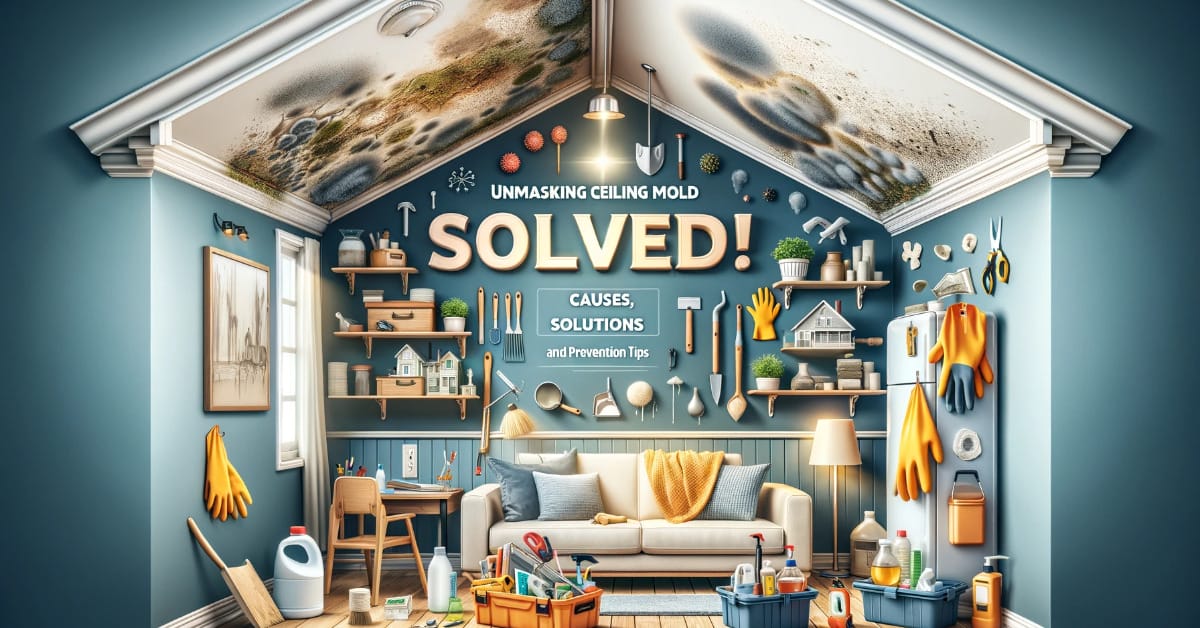
Ceiling mold is a common issue many homeowners face, and I’m here to help you tackle it with a game plan that’s both effective and straightforward.
Here’s Are the Steps I Will Cover:
- 🔍 Mold Source: Spot moisture issues, usually in bathrooms.
- 🥊 Gear Up: Gloves and mask ready.
- 🧪 Mold-Buster Mix: Borax, vinegar, and hot water.
- 🛡️ Prevention: Cool home (<75°F/24°C), airflow, and quick leak fixes.
In this article, we’ll explore the common causes of ceiling mold, effective solutions to get rid of it, and, most importantly, how to prevent it from reappearing.
Causes of Mold Growth on Ceilings

When I spot mold on a ceiling, my first thought is, “Where’s the water coming from?” It’s usually the first clue.
- 🌧️ Persistent Roof Leaks and Plumbing Issues: Roof leaks and plumbing woes often lead to ceiling mold.
- 💧 High Humidity Areas: Bathrooms with high humidity see more ceiling mold.
- 🌀 Poor Ventilation and Insulation: Hidden mold can signal bad ventilation or insulation problems.
- 🚿 Condensation and Water Intrusion: Condensation brings mold to ceilings.
- 🔍 Water Stains as Indicators: Water stains on ceilings may hint at mold.
- ❄️ Colder Climates and High Humidity: Cold, damp areas are hotspots for bathroom ceiling mold.
- 🚿 Condensation from Hot Showers: Steamy showers without good airflow can plaster mold on ceilings, especially in upstairs bathrooms.
Before rushing into a solution, I like to dig deep into the cause of the problem. Being cognizant of these causes and able to identify signs early on can lead the way to a comprehensive and lasting solution. There is no sense in treating symptoms; we should aim for a mold-free environment.
Steps for Removing Mold from a Ceiling
When you spot those unsightly patches or tiny circles on your ceiling, it’s a clear sign that mold has made an unwelcome appearance. Acting quickly is key to preventing its spread and ensuring it doesn’t take over your space.
Step 1: Identify Mold on the Ceiling

- First, let’s address the matter. What does mold look like on ceiling surfaces?
- Mold usually pops up as tiny circles or peculiar patches. Once you discern the unwelcome guest, you’ve got to act fast. Speedy removal prevents it from growing and spreading.
Step 2: Gather Protective Gear

- Without a doubt, you’ll need gloves, a mask, or a respirator. Safety is paramount in your mold battle. Neglecting gear can invite serious health hiccups like respiratory problems and skin rashes.
Step 3: Prepare your Cleaning Tools
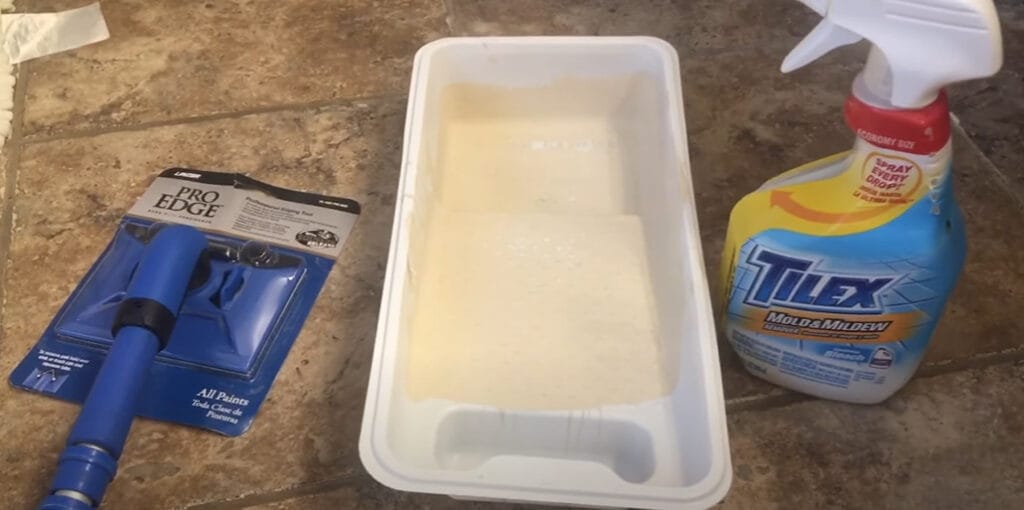
- Your tools for action include a spray bottle, scrub brush, step ladder, microfiber cloths, a sponge, and a bucket. With these in hand, you can kick off the mold eradication mission.
Step 4: Prepare the Cleaning Solution
- The cleaning formula is simple yet effective.
- Ready your mold removal solution by blending 2 tablespoons of borax, ¼ cup of vinegar, and 2 cups of hot water. You’ve got your ammunition.

Step 5: Apply the Solution
- Launch your attack by reaching up to the mold colony. Spray your mold removal potion on the affected zone. Scrub well with the rough side of a sponge and leave it to dry.
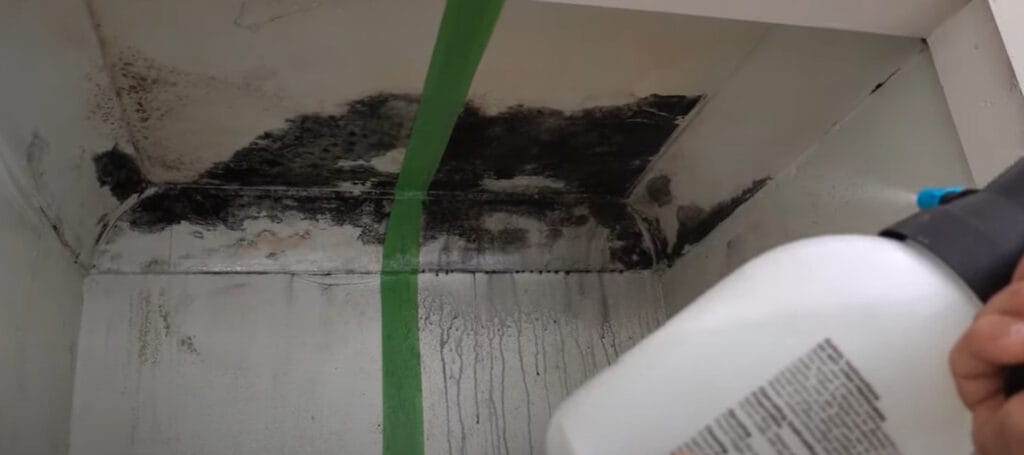
As you can see, removing mold on a ceiling is not overly complicated. Just take the appropriate steps and gear to keep health and safety in check.
Proactive Strategies for Mold-Free Living
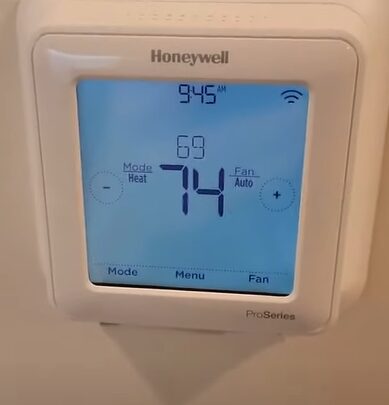
Want to nab mold in the bud? Avoiding a recurring mold issue is far easier when following a few practical steps. Mold thrives in temperatures around 70°F (20°C) or higher, so it’s crucial to keep an ambient temperature under 75°F (24°C) with your heating and cooling systems.
Let’s dive deeper into some of the best tactics to prevent ceiling mold:
- Routine Inspections: Spotting and fixing water leaks promptly is a non-negotiable. Ignoring a leaking pipe today could lead to a persistent and rapidly spreading mold situation down the line. Arranging for timely repairs to roofs, plumbing, and pipes can preempt moisture buildup, a primary cause of mold.
- Climate Control: Remember, mold loves warmth. Ensuring your indoor temperature is under 75°F (24°C) minimizes the likelihood of a mold infestation.
- Ventilation: The best weapon against mold due to condensation is effective ventilation. A circulation system that facilitates airflow can make a world of difference. Remove excess moisture and adjust the humidity levels with a solid ventilation system.
- Routine Bathroom Checks: This room is especially susceptible to mold due to habitual exposure to steam and water. Keep an eye out for early signs.
Remember, putting in the smart work to prevent mold growth from the get-go will keep you from future headaches. It’s all about creating the right environment – for you, not the mold.
Maintenance Tips to Keep Mold at Bay
Let’s highlight a manta to remember, “Prevention is always better than cure.” A few straightforward routines can drastically reduce the odds of mold being a frequent issue.
- Periodic Checks: Periodically check spaces around your home, especially the hidden ones and less visible areas, for any signs of mold.
- Seal Tiled Surfaces: Ensure all tiled surfaces are properly sealed to prevent water intrusion.
- Exhaust Fans: Install an exhaust fan to improve ventilation in moisture-prone areas like bathrooms.
- Openings for Ventilation: Open doors and windows when possible to regulate humidity levels.
- Bedroom Ventilation: Improve ventilation in the bedroom with open windows.
- Humidity Control: Reduce bedroom humidity using a dehumidifier or air conditioning.
- Clutter Avoidance: Avoid clutter by regularly untangling stacks of papers or clothing.
- Closet Organization: Maintain space between clothes and other items in closets to allow air circulation.
- Insulation Upgrade: Upgrade walls and ceiling insulation if condensation is a problem in the bedroom.
- Airflow: Ensure free airflow in your home with exhaust fans that vent outside, particularly in the kitchen and bathroom.
- Dryer Venting: Ensure clothes dryer vents do not end inside your home.
- Leak Prevention: Check that your roof, walls, or plumbing do not have leaks that could encourage mold growth.
- Dry Environment: Keep your home fully dry within 24–48 hours after a flood to prevent mold from taking hold.
Deciding Between DIY and Professional Mold Removal: A Practical Guide
When faced with the challenge of mold removal, it’s crucial to make an informed decision on whether to embark on a do-it-yourself mission or to call in the cavalry—professional mold remediators.
The table below simplifies the decision-making process, laying out clear scenarios where a DIY approach is sufficient and those that necessitate professional intervention.
| Decision Factor | DIY Mold Removal Suitability | When to Enlist Professional Help |
|---|---|---|
| Area Size | Manageable areas under 10 square feet | Extensive areas over 10 square feet |
| Surface Type | Non-porous surfaces are easy to clean | Porous surfaces, hard-to-reach spaces |
| Cause of Mold | Known and rectifiable causes | Persistent, unknown moisture sources |
| Health Concerns | No present allergies or respiratory issues | Existing health risks or sensitivities |
| Type of Mold | Non-toxic varieties | Potentially toxic molds like black mold |
| Location | Easily accessible areas | Complicated areas like HVACs, inside walls |
| Recurrence | Isolated incident | Recurring issue, despite previous efforts |
| Expertise and Tools | Basic cleaning equipment on hand | Specialized tools and expertise needed |
- Assess the Size and Scope: If it’s a small job and you’re handy, give it a go. If it’s widespread, step aside for the experts.
- Health First: Health issues and mold don’t mix. If there’s any risk, don’t risk it.
- Know Your Enemy: Can’t identify the mold or the moisture source? It’s time for a pro.
- Repeat Offender: If mold keeps returning, it’s time for a more thorough solution than you can provide.
Mold can be a tricky foe. It’s not just about the cleanup—it’s about ensuring it doesn’t make an encore appearance. So, weigh your options, consider the risks, and choose the path that leads to a safe, mold-free home.
Natural Alternatives to Chemical Mold Cleaners
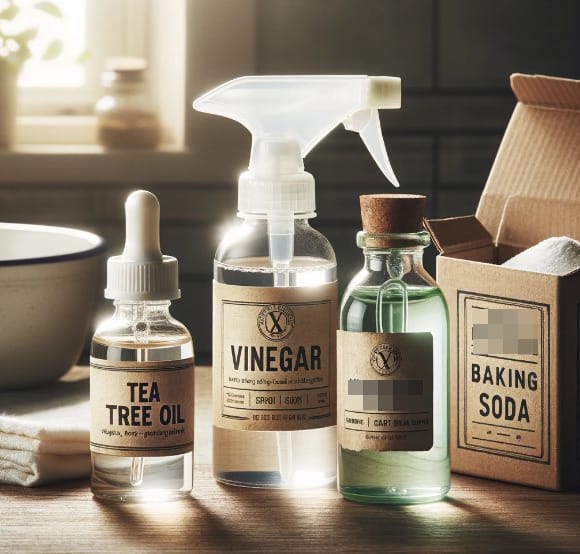
For those who are keen on keeping things green, there are several robust, natural options for mold removal:
- Tea Tree Oil Solution: Known for its natural fungicidal properties, it is a powerhouse against mold. Mix 2 teaspoons of tea tree oil with 2 cups of water in a spray bottle. Shake it well and spray the solution onto the affected area. Don’t rinse it off – the solution continues to work overtime, killing the mold and preventing it from returning.
- Hydrogen Peroxide: A safe alternative to bleach, hydrogen peroxide has antifungal, antiviral, and antibacterial properties. Apply a 3% concentration of hydrogen peroxide directly onto the moldy surface and let it sit for about 10 minutes. Scrub the area to remove mold and mold stains, then clean the surface.
- Vinegar: It’s not just for salads – vinegar is a mild acid that can kill 82% of mold species. Apply white distilled vinegar to the affected area and set it without rinsing. You can add essential oils like lemon for a more pleasant scent and add mold-killing power.
- Baking Soda: A mild, white mineral powder baking soda can kill mold in your home. Mix a quarter of a tablespoon of water in a spray bottle and shake until it has dissolved. Spray the moldy area with the baking soda and water solution, then use a scrub brush to remove all the mold from the surface.
When using these natural solutions, the approach remains the same as with chemical cleaners – protect yourself with gloves and a mask, ensure good ventilation, and always test a small area first to prevent any damage.
Frequently Asked Question
- Can I Paint Over the Ceiling Mold?
- Painting over mold is a temporary fix that doesn’t address the root problem. It will likely resurface if the underlying moisture issue isn’t resolved.
- Can Mold On My Ceiling Affect My Pets?
- Yes, mold spores can affect pets like humans, especially if they have allergies or weakened immune systems.
- Can Mold On The Ceiling Make My Home Uninhabitable?
- Severe mold infestations can make a home uninhabitable by compromising air quality and structural integrity.
- Does Homeowners Insurance Cover Mold Damage And Removal?
- Coverage varies by policy. Many insurance policies do not cover mold damage or removal unless directly related to a covered incident.
- Should I Use Bleach To Clean Mold Off The Ceiling?
- Bleach is not recommended on porous surfaces as it does not penetrate to kill the root structure. For non-porous surfaces, it can be used cautiously.
- What Are The Long-Term Effects Of Mold Exposure?
- Long-term mold exposure can lead to chronic respiratory conditions, persistent allergies, and, in some cases, more severe health problems.
- Are There Any Early Warning Devices For Ceiling Mold?
- Humidity and moisture meters can alert you to high moisture levels that could lead to mold growth.
References
Organizations:
- The U.S. Environmental Protection Agency (EPA). https://www.epa.gov/
- The Centers for Disease Control and Prevention (CDC). https://www.cdc.gov/index.htm
- The World Health Organization (WHO). https://www.who.int/
Books:
- “Mold: The War Within” by Kurt and Lee Ann Billings – provides insights into the effects of mold and methods for dealing with it.
- “The Mold Survival Guide: For Your Home and Your Health” by Jeffrey C. May and Connie L. May is a practical guide for homeowners.
Website Resources:
- The Indoor Air Quality Association. https://iaqa.org/resources/
- The American Industrial Hygiene Association (AIHA). https://www.aiha.org/
- The Spruce. https://www.thespruce.com/
Video References:
Maxkil
Andrew DIY
Howdini
Billshowto
Mechanicallyincleyend
